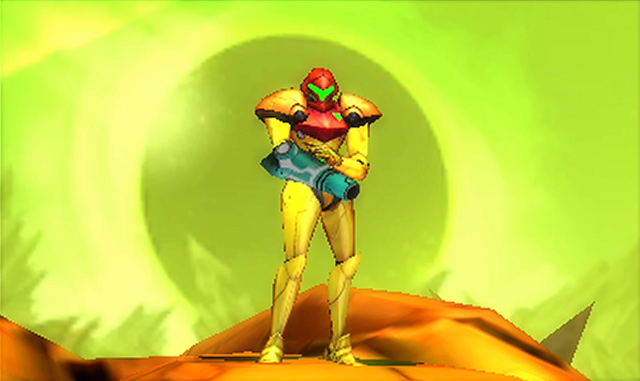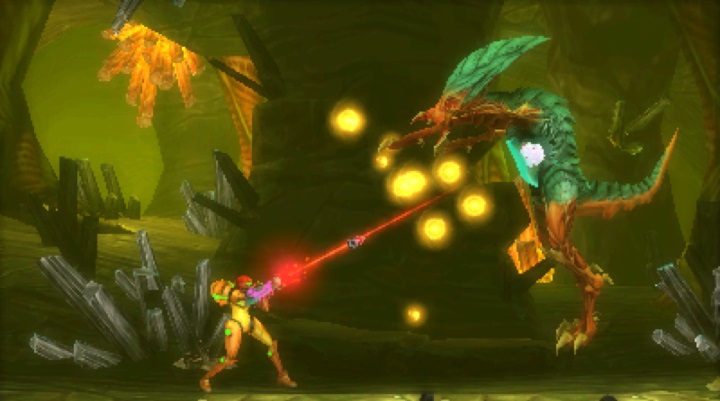Metroid, much like Nintendo’s other space series Star Fox, doesn’t get much time in the sun. While it still gets a new release more frequently than other more forgotten IPs like Kid Icarus, Custom Robo, and Golden Sun, fans of Nintendo’s space action-adventure series have been treated rather roughly with the last two titles. Many fans have claimed that — despite Other M and Federation Force being released in 2010 and 2016 — the series hasn’t had a true new release in nearly a decade. As such, it comes to no surprise that fans of the series were more than excited to see Nintendo’s announcement of not one, but two Metroid titles at E3 2017.
Metroid: Samus Returns is the first of these two games to be released. A remake of Metroid II: Return of Samus, the game aims to revitalize the title for newer audiences. But does Samus’ return warrant celebration, or has this space heroine seen her glory days in decades long gone?
The Plot

Back in 1986, Nintendo released Metroid II: Return of Samus for the original Game Boy. In that title, a team of Galactic Federation scientists were sent to planet SR388 in an attempt to exterminate the metroid threat posed by Space Pirate experimentation on the creatures. The extermination motion proving unsuccessful due to lost contact with the initial team, the Galactic Federation instead sent Samus Aran — a bounty hunter — to finish their mission.
Samus Returns — being the remake that it is — has left this plotline virtually untouched. While the ending has been tweaked, an opening animation has been added, and multiple bosses thrown in, the game shares the same basic premise as its predecessor.
Nevertheless, Samus Returns manages to further flesh out exactly what I liked about the original title — namely, the storytelling through environments and gameplay rather than dialogue or cutscenes. Samus is more in line with fan expectations thanks to her never-look-back attitude, while environmental storytelling such as the Chozo Ruins that were so deeply unexplained in Metroid II are still just as mysterious, but more clearly represented thanks to updated graphics. Meanwhile, the fluffless “just kill all the metroids” plotline still remains intact.
The Gameplay
The Good
While my initial impressions of Samus Returns made me think that this would just be a reskin of the original title with a few updated mechanics, the remake has been anything but. All complaints that I made in my Metroid II review have been addressed — namely the lack of a map, lack of landscape diversity, and reliance on instruction booklets — while new mechanics allow for a brand new experience.
One of these mechanic updates is the 360 degree aim. This is oddly enough the first game to feature 360 degree aiming in the 2D series of Metroid titles, primarily due to the fact that there hasn’t been a true 2D Metroid since Zero Mission in 2004. Since that game still used pixel-sprites and the Game Boy Advance’s D-Pad, it’s not really that surprising.
While this feature sounds like it wouldn’t add much to the game on paper, it does allow for the player to pick and choose their footing when in battle. Now, instead of madly leaping around the stage and getting uncomfortably close to enemies (particularly bosses), players can aim from afar if they want to avoid taking damage.
For those who like to take a more hands-on approach to fighting enemies, there is another means of taking out foes: the melee counter.
The melee counter is a feature possibly borrowed over from Other M, and is one of the gameplay features that I personally wanted to see return in a mainline Metroid title. With the simple press of the button and the right timing, Samus will knock enemies away before blasting them with a handful of arm cannon shots of your choosing.
This may seem overpowered from a viewer’s perspective, but in reality it has been carefully balanced with enemy placement, very selective opportunities for activation, and the lack of invulnerability frames during use. As a result, melee countering an enemy that is sitting a little too close to another is more likely to bring about more harm than good.

Other neat additions include the new Aeion abilities (such as the lightning armor above), the ability to switch between Ice, Grapple, and standard beams, as well as a trove of new bosses.
While the latter additions are unarguably great, the Aeion abilities are questionable depending on the type of player you are. Aeion abilities such as the Scan Pulse can seemingly break the game, but no more so than the X-Ray Visor from Super Metroid thanks to the limitations of the Aeion gauge — and as a result, the Aeion abilities feel more like tools akin to the missiles than the game-breaking abilities that they appeared to be in trailers.
That said, once the player unlocks more Aeion energy, the abilities can feel a bit unfair. Thankfully, none of the abilities need to be activated except in rare instances, so classic Metroid fans can avoid using them almost entirely depending on the goal at hand. There’s also still plenty to explore this time around, so fans shouldn’t be worried about any of these abilities getting in the way of their experience since very few locations are even remotely similar to that of the source material.
The Bad
Unfortunately, no game is without its flaws — and Samus Returns is no exception. While a few new bosses have been added to the game, the majority of the game still centers around hunting the various metroids. As a result, these boss-like encounters can become extremely repetitive after the first few experiences of these grotesque enemies.
If the number of metroids had been reduced, maybe given a few extra forms, or even diversity in battle-room layouts, the experience could have been vastly different. Instead, most of these battles will consist of finding out what the weakness is, taking a few hits while trying to figure out what to do, and then repeating this every four to ten or so times. While I would love to say that this doesn’t hurt the game that much, it did enough damage to harm my overall experience of the title.
Another personal gripe is that while some tutorials are necessary for learning new mechanics — namely melee countering — it feels as though it should have been added in the flavor text of a collectable powerup. Instead, the game provides a very basic tutorial during the first moments of gameplay to teach you everything from wall climbing to the melee counter. Thankfully, this gets out of the way rather quickly, but it honestly shouldn’t have been there in the first place since the game isn’t that much more complex than Super Metroid in terms of controls.
The Presentation

The presentation of Samus Returns is somewhat remarkable considering the hardware it was designed for. While the game could have undoubtedly benefited from releasing on the Nintendo Switch, the 3DS manages to bring the game to life with a wide range of dark, but colorful, visuals.
The game also sports a few remixed background themes from various titles across the series mixed among those from the source game. I can say with certainty that the remixes of Return of Samus‘s soundtrack settles my gripes with the original game’s music since they are much more in line with the series as a whole, even if the Surface of SR388 does still have a bit of upbeatness to it. Thankfully, more guilty themes such as the Game Boy’s awful Chozo Ruins theme have been overhauled with something much more fitting (below).
The Verdict
Without a doubt, Metroid: Samus Returns is a step in the right direction. With some consideration of the fact that this is a remake and not a stand alone game, I would even go so far as to say it is an amazing title. However, the drawback of this title being a remake is that it suffers from some flaws left over from its source material — namely the repetitive nature of the pseudo-boss encounters.
Had the metroid encounters been a little more diverse — or even a little less plentiful — I could easily have given the game a 9 or even a 10. While Metroid: Samus Returns will be remembered possibly as the game that brought the series back to life, as well as the definitive edition of Metroid II: Return of Samus, Nintendo had better have much bigger plans for Metroid Prime 4 if they hope to have the same effect on fans as they did with The Legend of Zelda: Breath of the Wild.
Only time will tell if Prime 4 will bring about a second coming for the series. But if you want to check out this remaster for yourself, you can pick it up for $39.99 over at Nintendo.










Published: Sep 14, 2017 07:19 pm